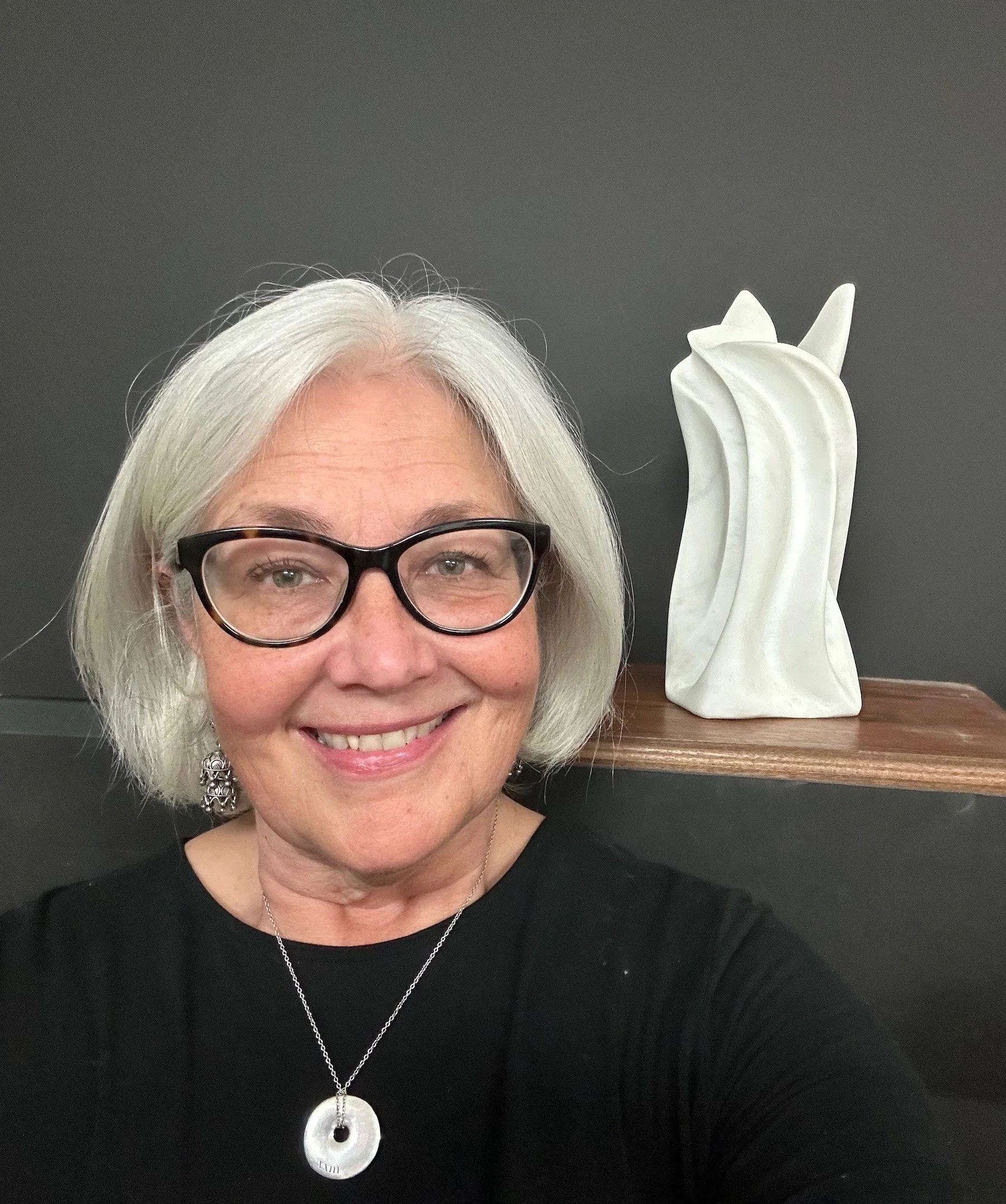Interview with art conservator Elizabeth Norton
Elizabeth Norton and her husband Wendel started the fine art conservation company, Norton Arts nearly 30 years ago. Based in Newton County, Arkansas, Norton Arts is a unique and valuable resource that provides specialized services for collectors, dealers, and museums in our state and around the country. More information can be found at nortonarts.com.
AAS: Elizabeth, tell me about yourself. Where did you grow up?
EN: I grew up in El Dorado. It was a pretty sweet place to live, surrounded by grandparents and lots of friends and family. One of my grandmothers had been a history teacher, so appreciating my own history became a real focus for me. My sister laughs at me because I still have clothes and all kinds of memorabilia from my teenage years. Preservation is at my core.
After graduating high school, I went to Hendrix. I did not have big plans for what came next. I was just excited to venture out into the world and explore. I began my freshman year as a math major. I love math – still do. But there was a creative side of me that was yearning to do more. I was involved in every music offering available.
Wendel Norton
One day I was working in the “art lab” on an assignment when this really handsome and sweet guy came over to help me. He had a pen that I needed to finish my project. He asked me out not long after that – and the rest is history.
Wendel was immersed in his passion for art, and I was looking for that kind of focus as well. My sophomore year I made the decision (with my parents’ full support and Wendel’s encouragement) to change my major to music. The arts were my passion. The art department was adjacent to the music department, so the art lab became my second home. Wendel taught me as much about materials, technique, and history as I had learned in classes.
AAS: When and how did Norton Arts get started?
EN: In 1989 Wendel, Vanessa, and I decided to move to New York City so that Wendel could spend more time studying art – “for a year or two.” He had graduated from Hendrix with a B.A. in Fine Art and had been spending more and more time studying at the Art Students League of New York. It made sense for the three of us to go as a family so that he could study full time. While there he also began working with Phillip Pavia, who was a well-known sculptor and who taught at the Arts Students League. Wendel developed his love of working in marble while working with Phillip.
Wendel was a perfect blend of artist, art historian, and scientist. Conservation was a natural offshoot of his love of creating art. He began working as Head Conservator at a conservation studio in New York City in 1990. A few years later he decided to branch out on his own as a conservator in private practice. When we moved back to Arkansas in 1994, we opened Norton Arts, Inc. I had been an educator but was very involved with Wendel’s artwork and conservation and was excited to start the company together.
AAS: Who are your typical clients?
EN: When we returned to Arkansas, we really had no idea about who our clients would be. We started out working with antique dealers who had paintings, frames, porcelain, and antiques that needed conservation. As our reputation began to grow, we began working with museums as well as private clients. There were also several businesses who specialize in framing and who had clients who needed conservation on paintings, paper, frames, and 3-dimensional pieces. Today we work with all of those as well as companies who deal with floods, fires and other disasters.
“Conservation is about preservation. It is important to respect the aging process and the history of artwork.”
AAS: What exactly is “conservation” versus “restoration” and where do you draw the line between the two?
EN: Conservation is about preservation. It is important to respect the aging process and the history of artwork. The goal is not to make something look like it’s brand new again. The goal is to stabilize and prevent further deterioration. In that process artwork always looks much better! Porcelain restoration is actually true restoration in most cases. On very valuable, museum pieces, however, one would choose to stabilize only. That is why in many museums with antiquities, you might see a ceramic or porcelain piece that has the restored part clearly visible.
Of course, there are always details that need attention. One of the basic tenets of conservation is that all materials are reversible. Because materials are constantly evolving and improving, it is critical that any materials be reversible. For instance, there was a time when relining paintings with wax was considered to be the correct way to conserve them. Over time it became clear that it was detrimental to paintings because the wax was rigid and did not allow for changes in temperature or humidity. As a result, it is common to see the concentric circles of craquelure that formed. And because the wax is irreversible, there is not much to be done to change the painting.
Previous and failed restorations are something we see a lot. Sometimes it is a matter of the conservator using the best materials available at the time with those materials now failing. Sometimes it is a conservator going too far in the wrong direction. In thirty years, I can remember only a few pieces that we felt were beyond hope.
AAS: I know you conserve more than just works on canvas or paper. What other types of materials do you conserve?
Wendel working on a stone sculpture.
EN: We are currently working on a variety of projects including two large scale sculptures and some smaller historic marble pieces. One of the sculptures is made of granite and the other is a large sculpture made of zinc. We also restored a large copper repoussé [a hammered metal] statue that had been vandalized. It had its own set of problems, but at least the material itself was less brittle.
The stone sculptures we are conserving have many small and large missing areas as well as broken components that must be pinned, filled, and matched to the original surface. Some missing pieces must be completely fabricated using matching stone.
‘Before’ photo of damaged scagliola column base at FUMC in Hot Springs.
‘After’ photo showing repair to the column base.
Last fall we received a call from FUMC [First United Methodist Church] in Hot Springs. Twenty years earlier we had restored their scagliola columns that had been damaged. They had discovered some new and major damage on some of the bases. Scagliola is an old technique of making plaster look like marble. Hot Springs FUMC has one of the more beautiful examples of scagliola that I have seen. The Arkansas House chamber is another example in Arkansas. Plaster is not as strong as stone and is easier to damage, especially in an area where lots of people congregate or walk. We built an armature inside the base of the column so that it had the support it needed. We then finished the surfaces to match the original colors and texture. There were dozens of chipped and damaged areas in addition to the major damage.
AAS: Tell me more about that zinc sculpture.
Lady Liberty undergoing repair.
EN: The zinc sculpture is a statue of Lady Justice, which was located on the top of the Jackson County Courthouse in Newport, where it was struck by lightning! The statue itself is about 10’ tall and it is on a base which is 1-1.5’ feet tall. The county has planned to reinstall it indoors rather than back on top of the courthouse.
This is a painstakingly long process for a variety of reasons. First, zinc is a brittle material, unlike copper which has some malleability to it. When it was struck it just sort of blew apart. There were cracks and pieces that were distorted. It became a kind of large-scale puzzle to reassemble. There is also evidence of previous restorations so there is residue from that to deal with.
We began by designing an interior armature to stabilize it. We then began putting the existing pieces back in place while fabricating and matching to the original surface missing areas. The closest intact photo we had of it was from the ground to the top of the roof. Details were not easy to see. The distortion has also added to the challenge. But we are making great progress on her! We still have a few months of work before completion.
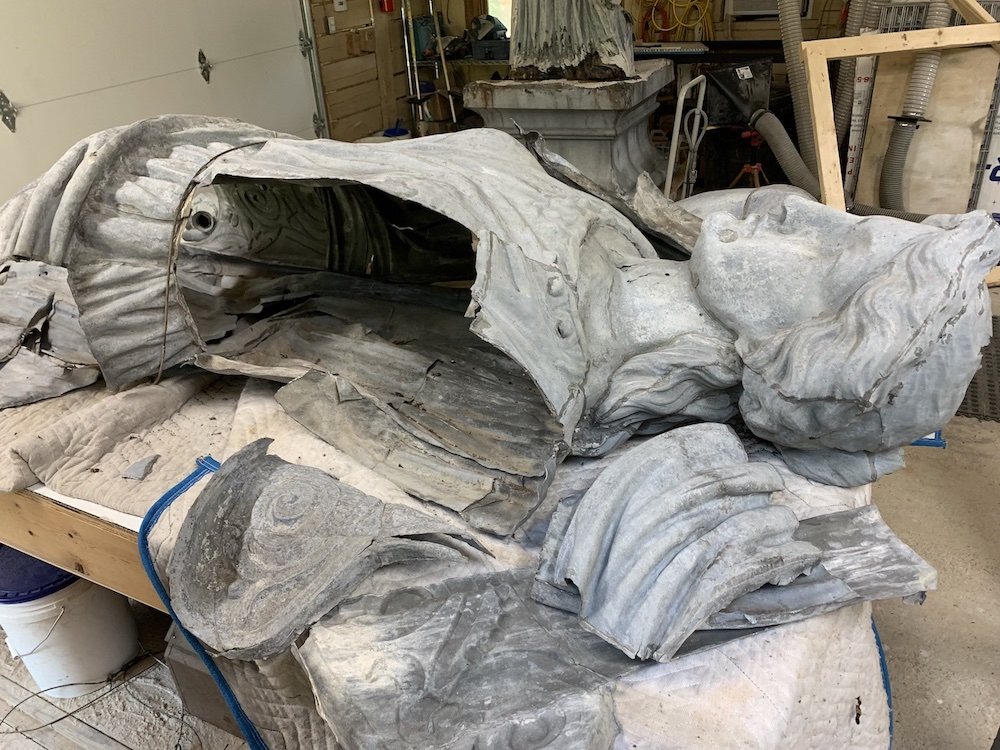

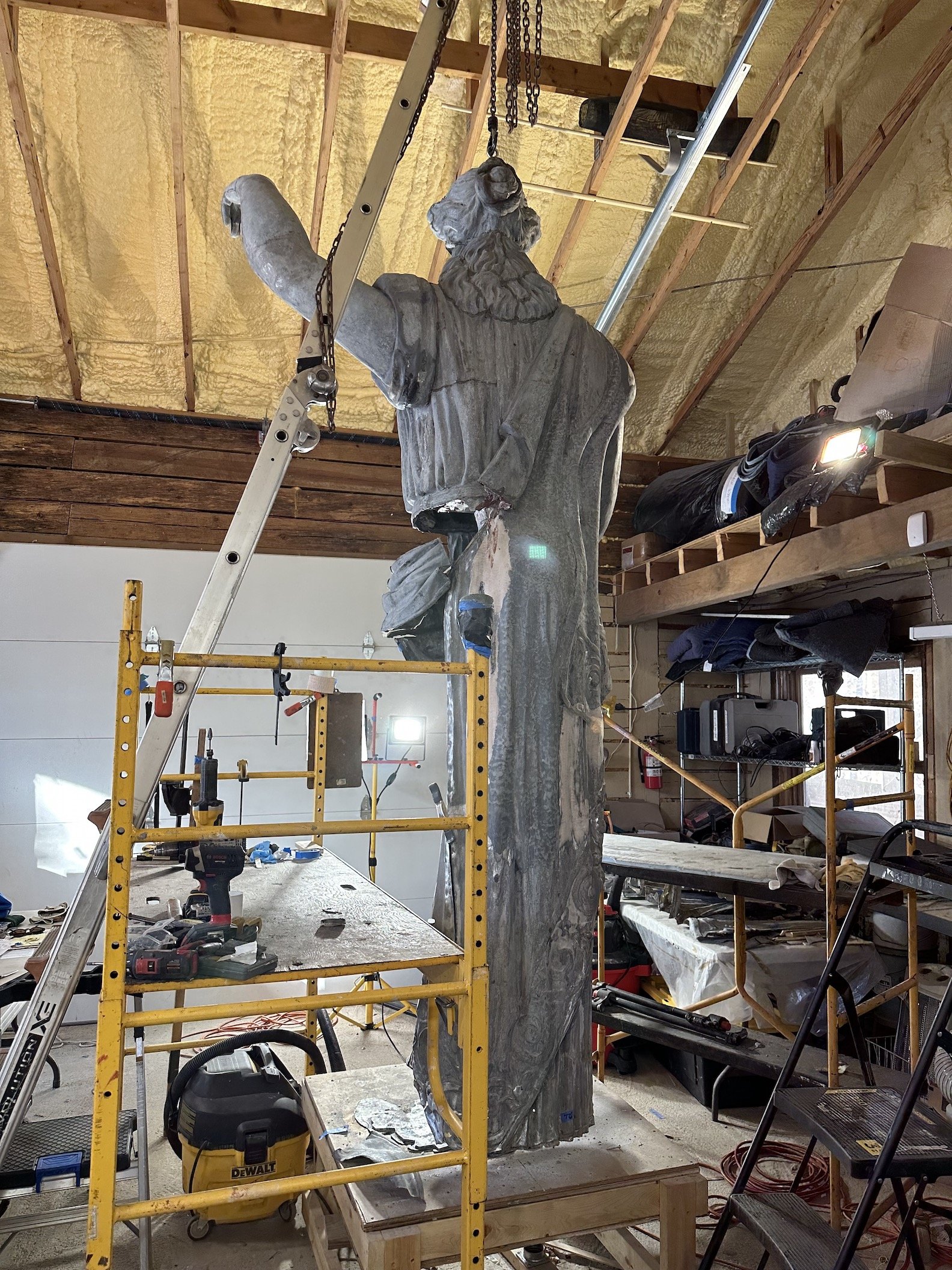
AAS: What are some of the most interesting pieces you have worked on?
But in His Duty Prompt at Every Call, He Watched, He Wept, He Prayed and Felt for All, Norman Rockwell,
EN: In our thirty years of conservation, we have seen some wonderful work! Some of the pieces have been by artists whose names are iconic and some works by lesser known but profoundly gifted artists. Sometimes the value is sentimental and, therefore, priceless to the owner. We have also worked in a variety of media, from paintings to marble to bronze to wood and more.
Wendel was a lifetime member of the Art Students League. Because they knew of his conservation background, he was asked to conserve the artwork that Norman Rockwell submitted to the Art Students League for a scholarship. Rockwell had left high school to pursue his passion of art. (He did receive the scholarship!). The artwork, which Rockwell created at the age of seventeen, was a charcoal drawing and was beautifully executed. I was surprised at the sophistication of his technique at such a young age. We are all familiar with his Saturday Evening Post cover illustrations, but he had far more in his portfolio than those!
Several years ago we replicated the Archibald Yell monument located in Evergreen Cemetery in Fayetteville. The original monument was so fragile that it really was impractical to restore it. Instead, the board chose to have us replicate the monument and to display the original in an interior setting. We replicated the new monument out of marble from Colorado. The lettering template was laser cut to match the original and the lettering on the monument itself was sandblasted by hand.
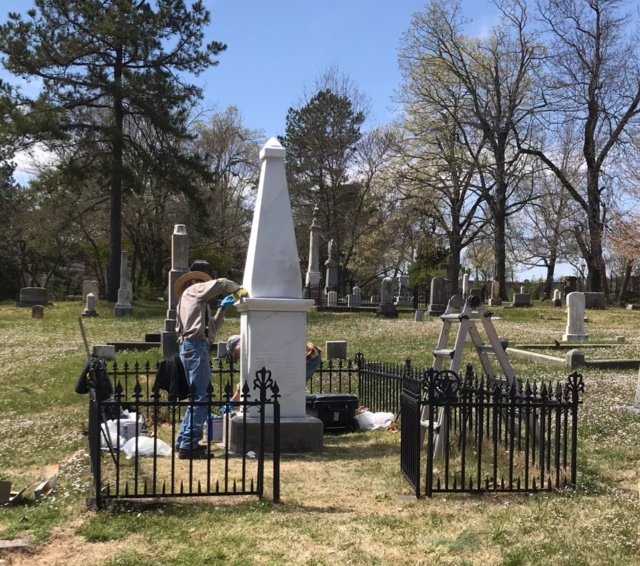
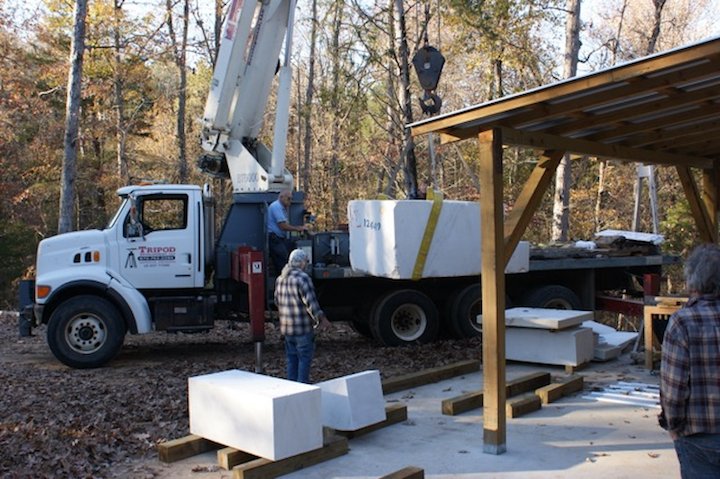
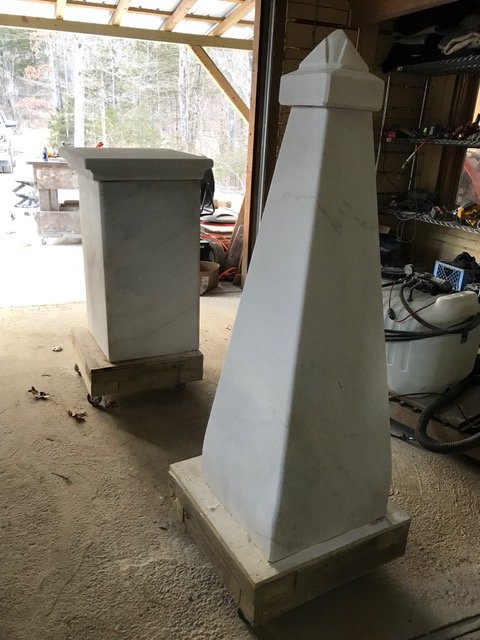

We currently have several antique lacquer pieces--an antique clock and a pair of Chinese lacquered chests. Conserving and restoring lacquer is a very specialized skill.
We also conserved an Egyptian sarcophagus. As you might expect, the surface was extremely fragile. We consolidated the hundreds of fragile and loose areas on the surface. We then filled the larger missing areas with archival materials to match the surface shape. But we did not attempt to paint that area to match the original. We finished the new material with a neutral color. You see this type of conservation in museums, especially in areas with antiquities as in the Metropolitan Museum of Art.
After Wendel’s passing in 2019, I made the decision to continue with conservation of all the media we had worked on through the years. I have recently made the decision to phase out painting conservation. Wendel was masterful at working with all types of materials, but paintings were his specialty. We will still consult with clients on their paintings and paper artwork but work with other conservators in the region for the actual conservation.
I mentioned that disaster mitigation is also one of our specialties. Floods and fires present a unique set of problems that must be dealt with quickly to mitigate further damage. We have worked extensively with homeowners to help them deal with large scale disasters.
AAS: I can only imagine how terrible it must be for a private collector to need to go through a disaster mitigation. It is not just value but also sentimental meaning too. Do you sometimes find yourself providing emotional support or comfort as well as.
EN: Private collectors are usually overwhelmed and just need reassurance that all is not lost. I suppose that is a kind of therapy. Private collectors are more likely to have those sentimental pieces that cannot be replaced. Fortunately, most of the time something can be done to save them.
Wendel once restored a painting that was in a moving van that caught on fire. As they were tossing things out of the truck away from the fire, one of the paintings caught something sharp and ripped. The heat had curled the edges of the tear as well. I just shook my head thinking that it was a lost cause. But Wendel was able to restore it to the point you could not even tell what had happened!
AAS: Do you employ a staff of artisans, or do you contract out the refabrication work?
EN: We have a small staff of conservators who specialize in 3-dimensional work. For paintings and paper, we have a group of conservators that we work with for our clients who need those services.
AAS: Tell me more about the limitations of conservation and restoration.
EN: We try to be honest with the client on the front end of what can or cannot be expected. Most people are realistic and appreciate the honesty. If a painting has a wax relining, for instance, we let them know the realities of trying to separate the painting canvas from the backing with the wax, which may cause more damage than currently exists. Oftentimes it makes more sense to consolidate the craquelure and leave the wax intact. That will help stabilize the painting to some degree.
Another case is when the painting is on a Masonite board or piece of wood. These materials tend to warp over time but removing the artwork from those materials can compound the damage.
We advise clients to store artwork in a climate-controlled environment. Lighting is a common problem too and should be designed to minimize the impact on artwork. If artwork has been improperly exposed to lighting that effects it, it cannot be returned to its original intensity of color. The best guidance there is to change its exposure going forward.
AAS: Sounds to me like conservation is its own art form as well as a science.
EN: Exactly. Conservation requires knowledge of materials as well as the history of techniques used with these materials. American Institute for Conservation is the professional organization that provides resources to all member conservators.
We recently received artwork that was exposed to water – some directly and some just from the moisture in the environment. The paper had become wrinkled, but that can be flattened. Some of it was tested and had active mold. This is where the science comes in. We were able to perform viable mold tests on sample pieces to get a sense of the extent mold growth. When necessary, we work with an industrial hygienist or other science experts to properly handle the problem.
AAS: Tell me about the process of working with Norton Arts.
EN: Our long-term clients reach us directly. We also receive referrals from multiple sources: museums, art galleries, insurance companies and word of mouth. Our website is www.nortonarts.com. We usually visit the client at the location of the artwork. Sometimes testing is required, in which case we take the piece for evaluation and return it with a written Conservation Treatment Report that includes an estimate. We do charge for each visit, but the fee is applied toward the conservation of the artwork if the client chooses to move forward with it. Our studio number is (870) 434-5119 if someone would like more information.
